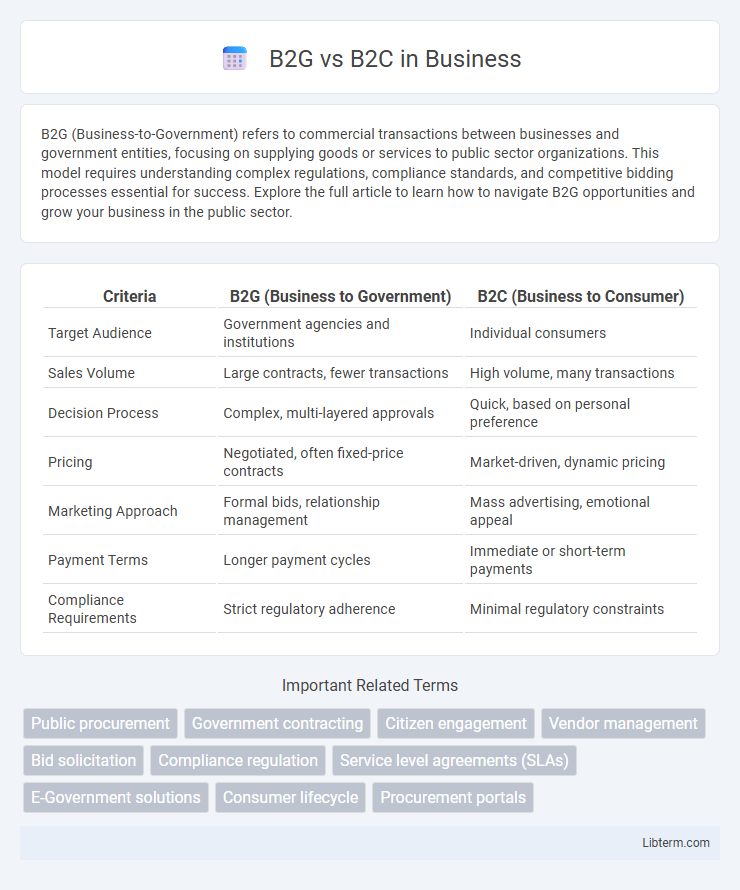B2G (Business-to-Government) refers to commercial transactions between businesses and government entities, focusing on supplying goods or services to public sector organizations. This model requires understanding complex regulations, compliance standards, and competitive bidding processes essential for success. Explore the full article to learn how to navigate B2G opportunities and grow your business in the public sector.
Table of Comparison
| Criteria | B2G (Business to Government) | B2C (Business to Consumer) |
|---|---|---|
| Target Audience | Government agencies and institutions | Individual consumers |
| Sales Volume | Large contracts, fewer transactions | High volume, many transactions |
| Decision Process | Complex, multi-layered approvals | Quick, based on personal preference |
| Pricing | Negotiated, often fixed-price contracts | Market-driven, dynamic pricing |
| Marketing Approach | Formal bids, relationship management | Mass advertising, emotional appeal |
| Payment Terms | Longer payment cycles | Immediate or short-term payments |
| Compliance Requirements | Strict regulatory adherence | Minimal regulatory constraints |
Understanding B2G and B2C: Key Definitions
B2G (Business-to-Government) refers to transactions where businesses provide products or services directly to government agencies, emphasizing compliance with public sector procurement regulations and long-term contracts. B2C (Business-to-Consumer) involves businesses selling goods or services directly to individual consumers, focusing on user experience, marketing, and rapid sales cycles. Distinguishing B2G from B2C is crucial for developing targeted strategies, as B2G emphasizes regulatory adherence and bidding processes, while B2C centers on consumer behavior and demand trends.
Core Differences Between B2G and B2C Models
B2G (Business to Government) focuses on selling products or services directly to government entities, requiring compliance with strict regulations, lengthy procurement processes, and often large contract values. B2C (Business to Consumer) targets individual consumers, emphasizing user experience, fast transactions, and mass marketing strategies to drive volume sales. The core difference lies in the complexity and length of the sales cycle, with B2G demanding detailed proposals and approvals, while B2C prioritizes customer convenience and quick purchase decisions.
Target Audience Analysis: Government vs Consumers
B2G (Business-to-Government) targets government agencies, requiring a deep understanding of regulatory compliance, procurement processes, and budget cycles to tailor offerings that meet public sector needs. B2C (Business-to-Consumer) focuses on individual consumers, emphasizing demographic insights, purchasing behavior, and emotional triggers to drive engagement and sales. Effective target audience analysis in B2G involves stakeholder mapping and policy alignment, while in B2C, segmentation and personalized marketing strategies are critical.
Sales Cycles: B2G vs B2C
B2G (Business-to-Government) sales cycles are typically longer, often spanning several months to years due to complex procurement processes, strict compliance requirements, and multiple stakeholder approvals. B2C (Business-to-Consumer) sales cycles are generally shorter, ranging from seconds to weeks, driven by individual buying decisions and less formalized purchasing methods. Understanding these differences helps businesses tailor their sales strategies effectively to meet the unique demands of government clients versus individual consumers.
Marketing Strategies for B2G and B2C Markets
Effective marketing strategies for B2G focus on building long-term relationships through compliance with procurement protocols, emphasizing transparency, and demonstrating value in public sector needs. B2C strategies prioritize emotional appeal, personalized content, and omnichannel engagement to capture diverse consumer preferences. Tailoring communication to decision-makers in B2G contrasts with mass-market targeting and influencer marketing prevalent in B2C.
Relationship Building: Navigating Government and Consumer Partnerships
B2G (Business-to-Government) relationship building demands a strategic approach to compliance, transparency, and long-term contract management with government entities. B2C (Business-to-Consumer) focuses on personalized engagement, brand loyalty, and emotional connection to foster consumer trust. Successful navigation of both markets requires tailored communication strategies, emphasizing regulatory understanding for B2G and customer experience optimization for B2C.
Regulatory and Compliance Considerations
B2G (Business-to-Government) transactions face stringent regulatory and compliance requirements including adherence to government contracting standards, security clearances, and audit trails, which are often more complex than B2C (Business-to-Consumer) regulations. B2C businesses primarily navigate consumer protection laws, privacy regulations like GDPR or CCPA, and product safety standards that focus on protecting individual customers rather than institutional stakeholders. Compliance in B2G requires detailed documentation and transparency to meet public sector accountability, while B2C demands robust data security measures and transparent marketing practices to ensure consumer trust.
Pricing Structures: B2G Contracts vs B2C Retail
B2G pricing structures typically involve fixed, long-term contracts with negotiated bids and compliance with government regulations, resulting in stable but complex payment terms. In contrast, B2C retail pricing is dynamic, driven by market competition, seasonal promotions, and consumer demand, often featuring transparent and flexible pricing models. B2G contracts prioritize cost-effectiveness and accountability, while B2C pricing emphasizes customer experience and immediate sales conversion.
Technology Integration in B2G vs B2C
Technology integration in B2G (Business-to-Government) focuses on compliance, security, and scalability to meet stringent regulatory requirements and public sector standards. In B2C (Business-to-Consumer), technology prioritizes user experience, personalization, and rapid innovation to engage a diverse consumer base. B2G often involves legacy system compatibility and complex procurement processes, while B2C leverages agile platforms and real-time data analytics for customer-centric solutions.
Future Trends in B2G and B2C Sectors
Future trends in B2G and B2C sectors highlight increased adoption of artificial intelligence and blockchain technology to enhance transparency, efficiency, and personalization. B2G markets are expected to see growth in smart city initiatives and digital government services, driven by AI-powered data analytics and secure blockchain platforms. B2C sectors will continue to evolve with immersive technologies like augmented reality and AI-driven customer experience tools, fostering deeper consumer engagement and personalized marketing strategies.
B2G Infographic

 libterm.com
libterm.com